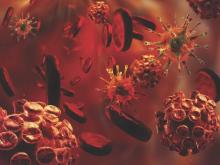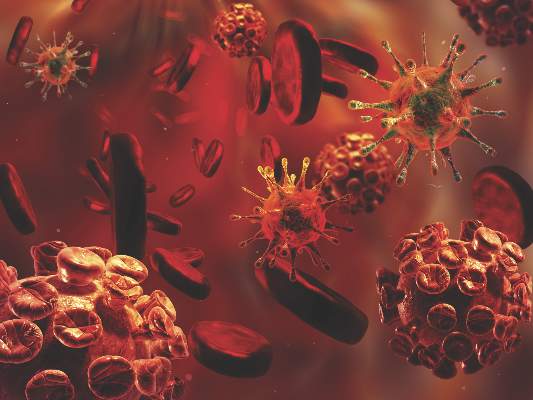User login
A new study concluded that enhanced liver fibrosis (ELF) was significantly more effective than were APRI and FIB-4 at predicting all-cause mortality in women infected with both HIV and hepatitis C virus.
“Using all three measures did not improve on the predictive value of ELF alone,” the study – led by Dr. Marion G. Peters of the University of California at San Francisco and published in the journal AIDS – said that adding all-cause mortality was chosen because “prior work noted that death certificates have significant limitations and liver disease may have been the underlying or contributing cause of septic death, renal death, or multisystem organ failure.”
Investigators recruited 381 women from the Women’s Interagency HIV Study, an ongoing, prospective, multicenter cohort trial conducted by the National Institutes of Health since 1993 to “investigate the impact of HIV infection on women in the [United States]” These women were enrolled in 1994-1995 and 2001-2002, all had HIV/HCV coinfection, and were evaluated twice a year with physical exams and laboratory testing, among other things. (AIDS. 2015 Nov 29. doi: 10.1097/QAD.0000000000000975)
All women underwent APRI and FIB-4 testing to determine the presence and severity of fibrosis. However, since both tests are known to be individually associated with all-cause mortality, investigators also performed ELF, a procedure that “utilizes direct measures of fibrosis, hyaluronic acid, procollagen III aminoterminal peptide and tissue inhibitor of matrix metalloproteinase.” In total, there were 2,296 ELF measurements taken from the study population.
Of the 381 women enrolled, 134 (35.2%) died by the end of the study. Of these, 78 (58.2%) had severe liver fibrosis, compared to 270 women who had none or mild fibrosis and 33 who had intermediate fibrosis. Receiver operator characteristic curves showed that ELF was consistently more reliable an indicator of all-cause mortality, especially based on data collected within 3 years of a subject’s death. When collected 1-3 years before death, ELF outperformed APRI 0.71 to 0.61 (P = .005) and outperformed FIB-4 0.71 to 0.65 (P = .06). Within 1 year of death, ELF produced area under the curve of 0.85, significantly higher than APRI’s 0.69 (P less than .0001) and FIB-4’s 0.75 (P = .0036).
“This study showed that in a large cohort of women with HIV and HCV coinfection, ELF was better in predicting all-cause mortality than [was] APRI and FIB-4,” Dr. Peters and her colleagues concluded, adding that “ELF could be useful in stratifying patients to identify those HCV patients at greatest and most-immediate risk of liver decompensation and in need of new all-oral HCV therapies.”
The WIHS study is funded by the NIH’s National Institute of Allergy and Infectious Diseases. One of the study’s coauthors, Dr. William Rosenberg, disclosed being an inventor of the ELF test, which is currently owned by Siemens, a company for which Dr. Rosenberg consults; however, Dr. Rosenberg “receives no income from ELF testing.”
A new study concluded that enhanced liver fibrosis (ELF) was significantly more effective than were APRI and FIB-4 at predicting all-cause mortality in women infected with both HIV and hepatitis C virus.
“Using all three measures did not improve on the predictive value of ELF alone,” the study – led by Dr. Marion G. Peters of the University of California at San Francisco and published in the journal AIDS – said that adding all-cause mortality was chosen because “prior work noted that death certificates have significant limitations and liver disease may have been the underlying or contributing cause of septic death, renal death, or multisystem organ failure.”
Investigators recruited 381 women from the Women’s Interagency HIV Study, an ongoing, prospective, multicenter cohort trial conducted by the National Institutes of Health since 1993 to “investigate the impact of HIV infection on women in the [United States]” These women were enrolled in 1994-1995 and 2001-2002, all had HIV/HCV coinfection, and were evaluated twice a year with physical exams and laboratory testing, among other things. (AIDS. 2015 Nov 29. doi: 10.1097/QAD.0000000000000975)
All women underwent APRI and FIB-4 testing to determine the presence and severity of fibrosis. However, since both tests are known to be individually associated with all-cause mortality, investigators also performed ELF, a procedure that “utilizes direct measures of fibrosis, hyaluronic acid, procollagen III aminoterminal peptide and tissue inhibitor of matrix metalloproteinase.” In total, there were 2,296 ELF measurements taken from the study population.
Of the 381 women enrolled, 134 (35.2%) died by the end of the study. Of these, 78 (58.2%) had severe liver fibrosis, compared to 270 women who had none or mild fibrosis and 33 who had intermediate fibrosis. Receiver operator characteristic curves showed that ELF was consistently more reliable an indicator of all-cause mortality, especially based on data collected within 3 years of a subject’s death. When collected 1-3 years before death, ELF outperformed APRI 0.71 to 0.61 (P = .005) and outperformed FIB-4 0.71 to 0.65 (P = .06). Within 1 year of death, ELF produced area under the curve of 0.85, significantly higher than APRI’s 0.69 (P less than .0001) and FIB-4’s 0.75 (P = .0036).
“This study showed that in a large cohort of women with HIV and HCV coinfection, ELF was better in predicting all-cause mortality than [was] APRI and FIB-4,” Dr. Peters and her colleagues concluded, adding that “ELF could be useful in stratifying patients to identify those HCV patients at greatest and most-immediate risk of liver decompensation and in need of new all-oral HCV therapies.”
The WIHS study is funded by the NIH’s National Institute of Allergy and Infectious Diseases. One of the study’s coauthors, Dr. William Rosenberg, disclosed being an inventor of the ELF test, which is currently owned by Siemens, a company for which Dr. Rosenberg consults; however, Dr. Rosenberg “receives no income from ELF testing.”
A new study concluded that enhanced liver fibrosis (ELF) was significantly more effective than were APRI and FIB-4 at predicting all-cause mortality in women infected with both HIV and hepatitis C virus.
“Using all three measures did not improve on the predictive value of ELF alone,” the study – led by Dr. Marion G. Peters of the University of California at San Francisco and published in the journal AIDS – said that adding all-cause mortality was chosen because “prior work noted that death certificates have significant limitations and liver disease may have been the underlying or contributing cause of septic death, renal death, or multisystem organ failure.”
Investigators recruited 381 women from the Women’s Interagency HIV Study, an ongoing, prospective, multicenter cohort trial conducted by the National Institutes of Health since 1993 to “investigate the impact of HIV infection on women in the [United States]” These women were enrolled in 1994-1995 and 2001-2002, all had HIV/HCV coinfection, and were evaluated twice a year with physical exams and laboratory testing, among other things. (AIDS. 2015 Nov 29. doi: 10.1097/QAD.0000000000000975)
All women underwent APRI and FIB-4 testing to determine the presence and severity of fibrosis. However, since both tests are known to be individually associated with all-cause mortality, investigators also performed ELF, a procedure that “utilizes direct measures of fibrosis, hyaluronic acid, procollagen III aminoterminal peptide and tissue inhibitor of matrix metalloproteinase.” In total, there were 2,296 ELF measurements taken from the study population.
Of the 381 women enrolled, 134 (35.2%) died by the end of the study. Of these, 78 (58.2%) had severe liver fibrosis, compared to 270 women who had none or mild fibrosis and 33 who had intermediate fibrosis. Receiver operator characteristic curves showed that ELF was consistently more reliable an indicator of all-cause mortality, especially based on data collected within 3 years of a subject’s death. When collected 1-3 years before death, ELF outperformed APRI 0.71 to 0.61 (P = .005) and outperformed FIB-4 0.71 to 0.65 (P = .06). Within 1 year of death, ELF produced area under the curve of 0.85, significantly higher than APRI’s 0.69 (P less than .0001) and FIB-4’s 0.75 (P = .0036).
“This study showed that in a large cohort of women with HIV and HCV coinfection, ELF was better in predicting all-cause mortality than [was] APRI and FIB-4,” Dr. Peters and her colleagues concluded, adding that “ELF could be useful in stratifying patients to identify those HCV patients at greatest and most-immediate risk of liver decompensation and in need of new all-oral HCV therapies.”
The WIHS study is funded by the NIH’s National Institute of Allergy and Infectious Diseases. One of the study’s coauthors, Dr. William Rosenberg, disclosed being an inventor of the ELF test, which is currently owned by Siemens, a company for which Dr. Rosenberg consults; however, Dr. Rosenberg “receives no income from ELF testing.”
FROM AIDS
Key clinical point: Enhanced liver fibrosis is the most effective way to predict all-cause mortality in women infected with both HIV and HCV.
Major finding: For 381 women with 2,296 ELF measurements, 134 (35.2%) died; area under the curve was stronger on ELF than APRI (0.85 vs. 0.69; P less than .001) and FIB-4 (0.85 vs. 0.75; P = .0036) within 1 year of death and 1-3 years before death.
Data source: 381 women with 2,296 ELF measurements, from the NIH’s Women’s Interagency HIV Study, a prospective, multicenter cohort of women at risk for, or currently diagnosed with HIV.
Disclosures: Study was supported by the National Institute of Allergy and Infectious Diseases. One coauthor (Dr. William Rosenberg) disclosed that he is an inventor of the ELF test, which is owned by Siemens, a company for which he consults.

